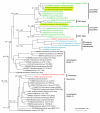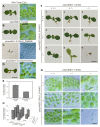Plastid chaperonin proteins Cpn60 alpha and Cpn60 beta are required for plastid division in Arabidopsis thaliana
- PMID: 19344532
- PMCID: PMC2670834
- DOI: 10.1186/1471-2229-9-38
Plastid chaperonin proteins Cpn60 alpha and Cpn60 beta are required for plastid division in Arabidopsis thaliana
Abstract
Background: Plastids arose from a free-living cyanobacterial endosymbiont and multiply by binary division as do cyanobacteria. Plastid division involves nucleus-encoded homologs of cyanobacterial division proteins such as FtsZ, MinD, MinE, and ARC6. However, homologs of many other cyanobacterial division genes are missing in plant genomes and proteins of host eukaryotic origin, such as a dynamin-related protein, PDV1 and PDV2 are involved in the division process. Recent identification of plastid division proteins has started to elucidate the similarities and differences between plastid division and cyanobacterial cell division. To further identify new proteins that are required for plastid division, we characterized previously and newly isolated plastid division mutants of Arabidopsis thaliana.
Results: Leaf cells of two mutants, br04 and arc2, contain fewer, larger chloroplasts than those of wild type. We found that ARC2 and BR04 are identical to nuclear genes encoding the plastid chaperonin 60 alpha (ptCpn60alpha) and chaperonin 60 beta (ptCpn60beta) proteins, respectively. In both mutants, plastid division FtsZ ring formation was partially perturbed though the level of FtsZ2-1 protein in plastids of ptcpn60beta mutants was similar to that in wild type. Phylogenetic analyses showed that both ptCpn60 proteins are derived from ancestral cyanobacterial proteins. The A. thaliana genome encodes two members of ptCpn60alpha family and four members of ptCpn60beta family respectively. We found that a null mutation in ptCpn60alpha abolished greening of plastids and resulted in an albino phenotype while a weaker mutation impairs plastid division and reduced chlorophyll levels. The functions of at least two ptCpn60beta proteins are redundant and the appearance of chloroplast division defects is dependent on the number of mutant alleles.
Conclusion: Our results suggest that both ptCpn60alpha and ptCpn60beta are required for the formation of a normal plastid division apparatus, as the prokaryotic counterparts are required for assembly of the cell division apparatus. Since moderate reduction of ptCpn60 levels impaired normal FtsZ ring formation but not import of FtsZ into plastids, it is suggested that the proper levels of ptCpn60 are required for folding of stromal plastid division proteins and/or regulation of FtsZ polymer dynamics.
Figures




References
-
- Bhattacharya D, Yoon HS, Hackett JD. Photosynthetic eukaryotes unite: endosymbiosis connects the dots. Bioessays. 2004;26:50–60. - PubMed
-
- Kuroiwa T, Kuroiwa H, Sakai A, Takahashi H, Toda K, Itoh R. The division apparatus of plastids and mitochondria. Int Rev Cytol. 1998;181:1–41. - PubMed
-
- Miyagishima SY. Origin and evolution of the chloroplast division machinery. J Plant Res. 2005;118:295–306. - PubMed
-
- Yang Y, Glynn JM, Olson BJ, Schmitz AJ, Osteryoung KW. Plastid division: across time and space. Curr Opin Plant Biol. 2008;11:577–584. - PubMed
Publication types
MeSH terms
Substances
LinkOut - more resources
Full Text Sources
Molecular Biology Databases
Research Materials

